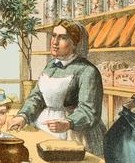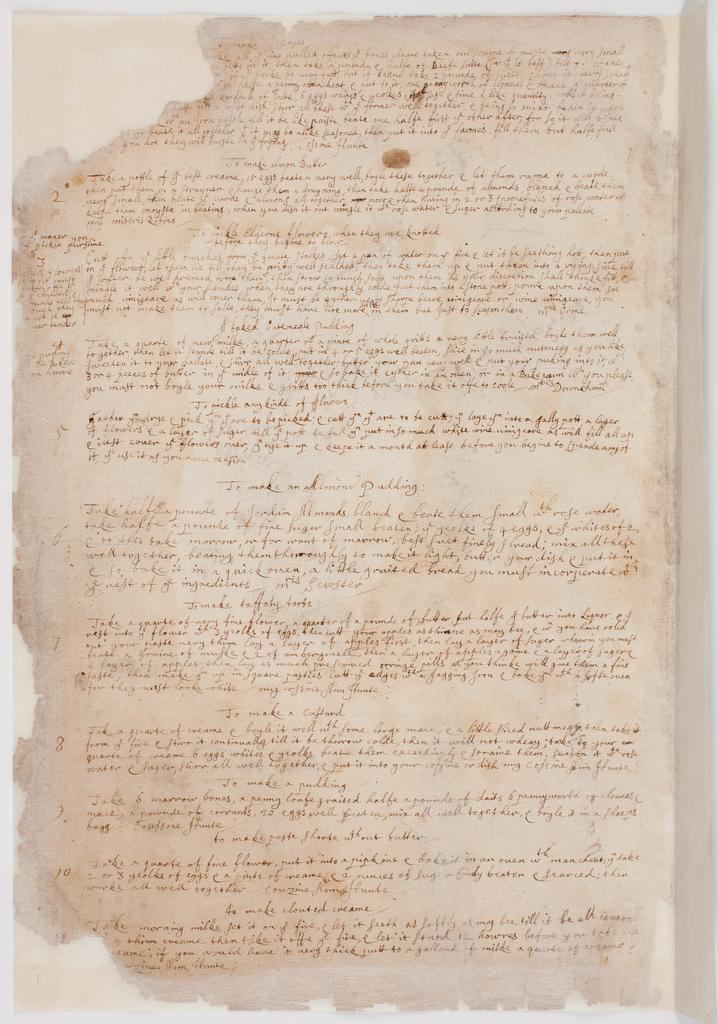As visions of baked goods dance through the pages of holiday Instagram, we bloggers at Past is  Present have decided to take a look at some of our historical manuscript cookbooks to see what early American bakers were cooking up instead. Like our fellow bloggers at Cooking in the Archives and the experts at Colonial Williamsburg, we were curious to see what our collections could tell us about the dishes early modern and colonial bakers served during the holidays and year round.
Present have decided to take a look at some of our historical manuscript cookbooks to see what early American bakers were cooking up instead. Like our fellow bloggers at Cooking in the Archives and the experts at Colonial Williamsburg, we were curious to see what our collections could tell us about the dishes early modern and colonial bakers served during the holidays and year round.
Of course historical cooking is not new to us at Past is Present. Since we started posting around the holidays back in 2009, we’ve blogged about the history of early American cooking and had one amazing cookoff between staff members and fellows. But since we wrote those posts, the Society has scanned and made freely available all of our manuscript cookbooks with the generous support of the Pine Tree Foundation, and we thought it was time for an update!
To view these scanned cookbooks, you can go directly to GIGI (our collection of digital images), click on “Manuscripts,” and do a keyword search for cookbooks. Alternatively, you can click here to pull up a list of catalog records of the scanned cookbooks. Each record includes a link to the scanned images in GIGI.
 The earliest cookbook in this collection is one of the most interesting, as it was owned by several women on both sides of the Atlantic. Once kept by Anna Cromwell, or Williams, in England (she dates the book December 23, 1650), the book was eventually transferred to Mary Parks and then Sarah Sartell Prentice in Grafton, Massachusetts, in the eighteenth century. Like many cookbooks from the period, it contains recipes for sweet and savory dishes and cosmetic and medicinal remedies. I toyed with the idea of making one or more of the recipes in the book, but the obscure ingredients made authentic recreation of the foodstuffs nearly impossible. Some foods, like “Queen Elizabeths cake,” incorporate musk and ambergris, both whale products that became popular flavorings in the seventeenth century, while the “haggasse pudding” requires sheep’s maw. Many recipes include rosewater—but an authentic rosewater, at least the best kind according to Anna, requires at least a month’s fermentation.
The earliest cookbook in this collection is one of the most interesting, as it was owned by several women on both sides of the Atlantic. Once kept by Anna Cromwell, or Williams, in England (she dates the book December 23, 1650), the book was eventually transferred to Mary Parks and then Sarah Sartell Prentice in Grafton, Massachusetts, in the eighteenth century. Like many cookbooks from the period, it contains recipes for sweet and savory dishes and cosmetic and medicinal remedies. I toyed with the idea of making one or more of the recipes in the book, but the obscure ingredients made authentic recreation of the foodstuffs nearly impossible. Some foods, like “Queen Elizabeths cake,” incorporate musk and ambergris, both whale products that became popular flavorings in the seventeenth century, while the “haggasse pudding” requires sheep’s maw. Many recipes include rosewater—but an authentic rosewater, at least the best kind according to Anna, requires at least a month’s fermentation.

At other times the lack of clarity in the instructions kept me from even thinking about picking up the spoon. For the “taffaty tarts,” the instructions say to put half of the butter into liquor but then never specify what to do with the butter-liquor mixture. I wonder if the purpose of including the liquor was to make an extra-flaky dough (as with a recent Cook’s Illustrated vodka pie crust). If anyone knows, please pass on your knowledge and I’ll try to make the recipe! Many of the medicinal recipes—”oyle of toads,” “a receipt against ye plague,” “to prevent a womans miscarrying with child“—are completely out of the question, especially when it comes to boiling live toads.
Clearly the author of our cookbook was familiar enough with certain methods of preparing her “paste,” or pastry, and other foods that she didn’t need to write down all of the instructions. Perhaps she watched the women who contributed recipes to her book, like her sister Elizabeth English and cousin Anne Hunte, as they prepared the dishes. This network of female bakers spent time baking together, sharing recipes, ideas, and maybe a little gossip. Rebecca Tannenbaum, who has written briefly about the book, has said that the book represents generations of women’s collective wisdom.
Not trying to recreate one of these dishes seems right, though, because they were “perishable arts,” as Laurel Thatcher Ulrich has called them. Twenty-first-century Instagrammers digitally preserve their pies and cookies with a metaphorical digital shellac or varnish, something that was not available to the earlier bakers. The early bakers recorded their process in sometimes cryptic instructions and occasionally preserved their books for years. Maybe it’s only fitting that the historical recipes remain available in traces only, the original perishable art gone with their maker, their words presenting just a hint of what they enacted. These words and traces, fragile in the original book, are now preserved, like Instagram photos, in digital ink.
